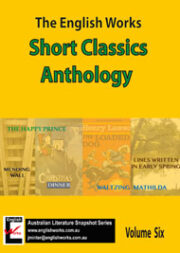
This enjoyable collection of short classics consists of beloved stories of Oscar Wilde, Mark Twain, Henry Lawson and Charles Dickens, as well as poems by Robert Frost, William Wordsworth and Edith Thomas.
It consists of guided questions to help you analyse layers of meaning and story-telling devices. These provide the basis for both reflective and creative modes of writing. It has tips for “Reading” and analysing a poem, a glossary and sentence models on analytical terminology.
As students work through this Anthology, they are encouraged to keep a Writing Folio.
1. Guided Questions
Answer the guided questions on each Model text. The questions help you analyse the text in greater depth. You will reflect upon the author’s or poet’s views, values, message and narrative (story-telling) and poetic devices.
2. A Reflective Piece
In your Reflective piece, you will draw upon the answers to the Guided Questions. You will use the author’s themes and key ideas to develop your own piece of writing.
In your Reflective piece, you will include personal examples and observations, sprinkled with your own thoughts, feelings and evaluation. By researching examples of people in similar situations, you will make connections between your own observations and other people’s behaviour, attitudes and achievements. This will help you draw conclusions and make predictions.
3. A Creative Piece
Drawing upon the ideas in the Model text, you will write your own imaginative piece of writing. You will explore different narrative styles, such as monologues and first and third person narratives.
Following the tips, you will include similar symbols and story-telling devices to enliven your piece and to add extra layers of meaning. You will use dialogue to create relatable characters and to capture their thoughts and feelings. Drawing upon models such as The Loaded Dog, you will develop a humorous piece of writing, while the poems encourage you to think in symbolic and abstract ways.
Volume 6: Short Classics Anthology (A5 Booklet) (978-0-9924942-1-6)